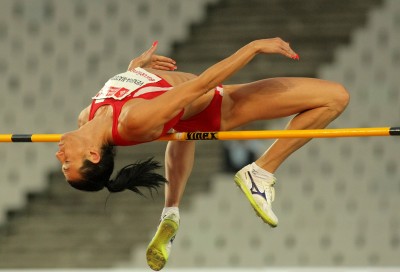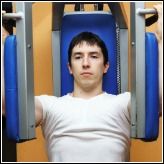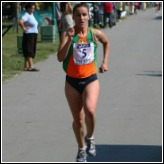How to High Jump In 7 Steps

If you are new to jumping and want to learn how to high jump, here are some steps that should guide you.
1. Normal high jump bars are solid and can sometime put beginner athletes off if they were to land on it- it hurts. So, if you are new to high jumping, I recommend that you use a bungee cord or a flexible high jump bar in your practice sessions. The additional benefit is that if you were to dislodge the bar, you don’t have to keep replacing every time this happens.
2. Find the correct takeoff leg from which to jump. A simple way to check this is to have someone push you from behind. You will immediately adjust your footing to re-gain your balance. The leg you use to adjust your balance is most likely to be the correct one to high jump from. Let’s say you put your left leg forward- then you should use your left leg to jump from – this is the leg you are most confident in.
3. Your complete approach run should use between 5-8 strides. If you are using the Fosbury flop technique, the last 3-5 stride will be executed using a curved run-up. The Fosbury flop approach run is ‘J’ shaped (the curved end is at the takeoff point) and the jumper should start the run slowly then increase the speed steadily towards the takeoff.
The final 2 strides of the approach should be fast and snappy with a da-daa rhythm. If there are any adjustments to be made in the approach run, you should only make them once you are completely warmed up.
4. The plant (the placing of the takeoff leg to the ground) should be made from just inside to the nearest standard (the upright, where the bar is placed) and about an arm’s distance from the bar. This allows you the time to get up and over the bar. Your takeoff foot should be pointed toward the far upright.
5. After the plant your focus should be on a powerful and quick knee drive. Your knee should be driven up and turned slightly inwards (away from the landing area). This will aid the rotation around the body’s longitudinal axis. The outcome being that you end up with your back to the bar ready to clear it head first. You will see that your shoulders and torso should follow the knee.
6. If the takeoff has been executed properly the jumper should naturally rotate around the bar. This is sometime seen as the jumper arching their body over the bar. The bar clearance is achieved by throwing your head back with your chin up just before your buttock is over the bar. This causes the shoulders to drop and the hips to rise.
Keep in mind that if you attempt the bar clearance too soon this will stop you from gaining height, so delay arching until you gain maximum height from your leg drive.
7. As you clear the bar, you should tuck your chin into your chest. This action will cause your legs to rise and help them to clear the bar after your hips have passed over. You should try to land as high on your shoulders as possible. This should cause you to continue to rotate and do a backward somersault as you land.
These tips for learning how to high jump are only for beginners. If you are a professional, you should talk to your coach about more advanced guidelines.
Sign Up For The Latest Track And Field News And Improve Your Athletic Performance!
From "How to High Jump In 7 Steps" Back To "Faster, Stronger, Better – Your Shortcut To Improved Athletic Performance"
Click here if you want to learn how to high jump as a more advanced athlete







